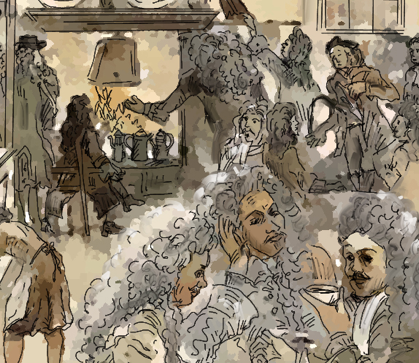October 24, 2009
Murphy, Anne L. (2009) Trading options before Black-Scholes: a study of the market in late seventeenth-century London. Economic History Review, 62/1: 8-30.

The ledger of the financial broker Charles Blunt contains the details of some 1,500 transactions realized between 1692 and 1695, about a third of which regard the then novel trade in equity options (p.9). The technique had arisen in the 1620s in the commodity market and was proving very useful in the decade following the Glorious Revolution, when some 100 joint-stock companies were floated in London (p.10). During the boom of the early 1690s, it is likely that “several thousand derivatives were transacted each year”.
Read the rest of this entry »
 4 Comments |
4 Comments |  Early Modern, Economic History, Europe, reading notes | Tagged: 1600s, capital market, derivative, early finance, England, exchange, finance, financial history, financial innovation, financial instruments, Glorious Revolution, joint stock companies, London, stock-market, stockjobbers |
Early Modern, Economic History, Europe, reading notes | Tagged: 1600s, capital market, derivative, early finance, England, exchange, finance, financial history, financial innovation, financial instruments, Glorious Revolution, joint stock companies, London, stock-market, stockjobbers |  Permalink
Permalink
 Posted by Ben
Posted by Ben
October 9, 2009
Murphy, Anne L. (2006) “Dealing with Uncertainty: Managing Personal Investment in the Early English National Debt”, History, 91/302, 200-17.

The sums involved in the so-called English Financial Revolution following the arrival on the throne of William III were altogether not that important: £6.9m from 1688 to 1702 while the government budget over the period reached £72m. However, “the impact of those novel methods of fund-raising was considerable”. In particular because small wealth-owners represented a large share of these early investors (p.201). Samuel Jeake, a merchant from Rye (East Sussex) was one of those small investors. He recorded his thought and his transactions in a diary and a few letters (p.202). Read the rest of this entry »
 Leave a Comment » |
Leave a Comment » |  Early Modern, Economic History, Europe, reading notes | Tagged: Bank of England, behavioral economics, behavioral finance, capital, capital market, central bank, early finance, England, finance, financial markets, financial revolution, London, lottery, portfolio, portfolio management, public finance, Rye, small investors, stock-market, stocks, uncertainty, William III |
Early Modern, Economic History, Europe, reading notes | Tagged: Bank of England, behavioral economics, behavioral finance, capital, capital market, central bank, early finance, England, finance, financial markets, financial revolution, London, lottery, portfolio, portfolio management, public finance, Rye, small investors, stock-market, stocks, uncertainty, William III |  Permalink
Permalink
 Posted by Ben
Posted by Ben
August 31, 2009
Frehen, Rik, William Goetzmann and Geert Rouwenhorst (2009) “New Evidence on the First Financial Bubbles”, Yale international Center for Finance, Working Paper 04, 24p.



This article is available online.
Why did investors decide to bet on the various companies that would form the three 1720 bubbles in France, England and the Netherlands? (p.1). How did these bubbles affect companies which unlike the Compagnie des Indes and the South Sea Company were neither involved in the Atlantic trade nor in public finance?
Read the rest of this entry »
 3 Comments |
3 Comments |  Early Modern, Economic History, Europe, reading notes | Tagged: 1700s, Amsterdam, Bank of England, bubble, crash, early finance, East India Company, England, finance, financial bubble, financial crisis, financial history, France, insurance, insurance company, IPO, joint stock company, London, London Assurance, Mississipi Bubble, Mississipi Company, Netherlands, Paris, private finance, Royal African Company, Royal Exchange Assurance, South Sea Bubble, South Sea Company, stock-market, VOC, WIC |
Early Modern, Economic History, Europe, reading notes | Tagged: 1700s, Amsterdam, Bank of England, bubble, crash, early finance, East India Company, England, finance, financial bubble, financial crisis, financial history, France, insurance, insurance company, IPO, joint stock company, London, London Assurance, Mississipi Bubble, Mississipi Company, Netherlands, Paris, private finance, Royal African Company, Royal Exchange Assurance, South Sea Bubble, South Sea Company, stock-market, VOC, WIC |  Permalink
Permalink
 Posted by Ben
Posted by Ben
August 30, 2009
Flandreau, Marc, Christophe Galimard, Clemens Jobst and Pilar Nogués-Marco (2009) “The bell-jar: commercial interest rates betwee two revolutions” in The Origin and Development of Financial Markets and Institutions. From the Seventeenth Century to the Present, eds. Jeremy Atack and Larry Neal, Cambridge: Cambridge University Press, 161-208.



An earlier version of this paper is available here.
For institutionalist economists as well as for contemporary commentators, the wealth of nations in 18th century Europe was rooted in their political system which influenced the level of interest rates and thus trade (p.165). The confidence investors had in the government’s credit was thus seen as critical (tellingly John Law’s primary aim was to bring interest rates down; p.166). Read the rest of this entry »
Read the rest of this entry »
 Leave a Comment » |
Leave a Comment » |  Early Modern, Economic History, Europe, reading notes | Tagged: 1600s, 1700s, Amsterdam, bankers, banking, Braudel, capital, capital market, corporate finance, development, development economics de Soto, early finance, England, finance, financial centre, financial history, France, Glorious Revolution, institutionalist economics, interest rates, London, market integration, merchant bankers, merchants, money, Netherlands, NIE, Paris, private finance, public finance |
Early Modern, Economic History, Europe, reading notes | Tagged: 1600s, 1700s, Amsterdam, bankers, banking, Braudel, capital, capital market, corporate finance, development, development economics de Soto, early finance, England, finance, financial centre, financial history, France, Glorious Revolution, institutionalist economics, interest rates, London, market integration, merchant bankers, merchants, money, Netherlands, NIE, Paris, private finance, public finance |  Permalink
Permalink
 Posted by Ben
Posted by Ben
August 21, 2009
Velde, François R. (2009) “Was John Law’s System a bubble? The Mississipi Bubble revisited” in The Origin and Development of Financial Markets and Institutions. From the Seventeenth Century to the Present, eds. Jeremy Atack and Larry Neal, Cambridge: Cambridge University Press, 99-120.



A slightly different version of this paper is available online.
The shares of the Compagnie des Indes created by John Law to manage the colonization of Louisiana, public finances and monopolies went from 250 Livres in July 1718 when the initial offering closed to just under 10,000 L days before Christmas 1719 and finally to 50 L in March 1721 (p.108). Can this jump followed by an even more impressive collapse in under 3 years be described as a bubble? (p.109) Read the rest of this entry »
 Leave a Comment » |
Leave a Comment » |  Early Modern, Economic History, Europe, reading notes | Tagged: 1700s, bank, bonds, bubble, Compagnie des Indes, early finance, finance, financial crisis, financial history, financial institutions, France, John Law, managed market, Mississipi Bubble, Mississipi Company, Paris, public finance, scheme, shares |
Early Modern, Economic History, Europe, reading notes | Tagged: 1700s, bank, bonds, bubble, Compagnie des Indes, early finance, finance, financial crisis, financial history, financial institutions, France, John Law, managed market, Mississipi Bubble, Mississipi Company, Paris, public finance, scheme, shares |  Permalink
Permalink
 Posted by Ben
Posted by Ben
August 18, 2009
Quinn, Stephen and Willam Roberds (2006) “An Economic Explanation of the Early Bank of Amsterdam, Debasement, Bills of Exchange and the Emergence of the First Central Bank”, Federal Bank of Atlanta. Working Papers Series, 13: 50p.*



This paper is available online.
Introduction
The United Provinces suffered from what Adam Smith termed the “small state” problem: it was awash in foreign coin and had little control over their quality, thus suffered from their constant debasement (p.1). Debtors always have an incentive to pay their due with debased coins. But this practice is only viable if the seigniorage he pays to the mint is lower than the amount of silver he saves in the operation. De facto, there is collusion between the mint and the debtor against the creditor (p.4). Read the rest of this entry »
 Leave a Comment » |
Leave a Comment » |  Early Modern, Economic History, Europe, reading notes | Tagged: 1600s, Amsterdam, bank, Banking History, business history, coin, coins, debasement, early finance, exchange bank, finance, financial history, financial innovation, Golden Age, Holland, Netherlands, Wisselbank |
Early Modern, Economic History, Europe, reading notes | Tagged: 1600s, Amsterdam, bank, Banking History, business history, coin, coins, debasement, early finance, exchange bank, finance, financial history, financial innovation, Golden Age, Holland, Netherlands, Wisselbank |  Permalink
Permalink
 Posted by Ben
Posted by Ben
August 12, 2009
Quinn, Stephen (2001) “The Glorious Revolution’s Effect on English Private Finance: A Microhistory 1680-1705”, The Journal of Economic History, 61/3: 593-615.



Disclaimer: this summary is written by the contributors of the blog and not by the author of the article. Any mistake is Manuel’s fault (and he shall be punished).
Introduction
According to North and Weingast’s famous thesis, the investiture of William III of England in 1688, the “Glorious Revolution”, triggered a quick modernization of the British financial system – prompting in turn a fall of the interest rates. But the arrival of the new king also led the realm into a new war against France which lasted nine years and increased public debt from £1 million to £19 million (⅓ of the national income; p.593). Read the rest of this entry »
 Leave a Comment » |
Leave a Comment » |  Early Modern, Economic History, Europe, reading notes | Tagged: 1600s, 1700s, bank, Bank of England, banker, crowding out, Douglass North, early finance, East India Company, England, finance, financial history, financial market, financial revolution, Glorious Revolution, goldsmith, Great Britain, institution, interest rates, investment, loan, London, modernization, New Institutional Economics, Nobel prize, Parliament, public finance, William III |
Early Modern, Economic History, Europe, reading notes | Tagged: 1600s, 1700s, bank, Bank of England, banker, crowding out, Douglass North, early finance, East India Company, England, finance, financial history, financial market, financial revolution, Glorious Revolution, goldsmith, Great Britain, institution, interest rates, investment, loan, London, modernization, New Institutional Economics, Nobel prize, Parliament, public finance, William III |  Permalink
Permalink
 Posted by Ben
Posted by Ben
August 10, 2009
Carlos, Ann M., Jennifer Key and Jill L. Dupree (1998) “Learning and the Creation of Stock-Market Institutions: Evidence from the Royal African and Hudson’s Bay Companies, 1670-1700”, The Journal of Economic History, 58/2: 318-344.



Disclaimer: this summary is written by the blog and not by the authors of the article. Any mistake is Manuel’s fault.
Introduction
“England’s emergence as an international trading nation in the seventeenth century can be linked to the growth of trading arrangements that allowed for a longer life of capital either […] as a joint-stock trading company” (p.318).
According to North and Weingast’s famous thesis this emergence was made possible by the reforms brought by the 1688 Glorious Revolution. However the authors underline the fact that markets don’t grow instantaneously and it takes some times for the actors to learn how to use the market (p.319). Read the rest of this entry »
 Leave a Comment » |
Leave a Comment » |  Early Modern, Economic History, Europe, reading notes | Tagged: 1600s, 1700s, bankers, brokers, corporation, early finance, East India Company, England, finance, financial history, financial intermediaries, financial market, Glorious Revolution, goldsmith bankers, Great Britain, Hudson Bay Company, know-how, learning curve, London, premodern finance, Royal African Company, secondary market, securities, shareholders, stock exchange, stock-market, United Kingdom |
Early Modern, Economic History, Europe, reading notes | Tagged: 1600s, 1700s, bankers, brokers, corporation, early finance, East India Company, England, finance, financial history, financial intermediaries, financial market, Glorious Revolution, goldsmith bankers, Great Britain, Hudson Bay Company, know-how, learning curve, London, premodern finance, Royal African Company, secondary market, securities, shareholders, stock exchange, stock-market, United Kingdom |  Permalink
Permalink
 Posted by Ben
Posted by Ben




 Posted by Ben
Posted by Ben 


















